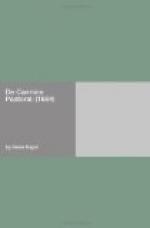And this must needs be a hard Task, since I have no guide,
neither Aristotle nor Horace to direct me.... And I am of
opinion that none can treat well and clearly of any kind of
Poetry if he hath no helps from these two (p. 16).
In “The Third Part,” when he begins
to “lay down” his Rules for
writing Pastorals,” he declares:
Yet in this difficulty I will follow Aristotle’s
Example, who
being to lay down Rules concerning Epicks,
propos’d Homer
as a Pattern, from whom he deduc’d
the whole Art; So I will
gather from Theocritus and Virgil,
those Fathers of
Pastoral, what I shall deliver
on this account (p. 52).
These passages represent the apogee of the neoclassical criticism of pastoral poetry. No other critic who wrote on the pastoral depends so completely on the authority of the classical critics and poets. As a matter of fact, Rapin himself is not so absolute later. In the section of the Reflexions on the pastoral, he merely states that the best models are Theocritus and Virgil. In short, one may say that in the “Treatise” the influence of the Ancients is dominant; in the Reflexions, “good Sense.”
Reduced to its simplest terms, Rapin’s theory is Virgilian. When deducing his theory from the works of Theocritus and Virgil, his preference is almost without exception for Virgil. Finding Virgil’s eclogues refined and elegant, Rapin, with a suggestion from Donatus (p. 10 and p. 14), concludes that the pastoral “belongs properly to the Golden Age” (p. 37)—“that blessed time, when Sincerity and Innocence, Peace, Ease, and Plenty inhabited the Plains” (p. 5). Here, then, is the immediate source of the Golden Age eclogue, which, being transferred to England and popularised by Pope, flourished until the time of Dr. Johnson and Joseph Warton.
In France the most prominent opponent to the theory formulated by Rapin is Fontenelle. In his “Discours sur la Nature de l’Eglogue” (1688) Fontenelle, with studied and impertinent disregard for the Ancients and for “ceux qui professent cette espece de religion que l’on s’est faite d’adorer l’antiquite,” expressly states that the basic criterion by which he worked was “les lumieres naturelles de la raison” (OEuvres, Paris, 1790, V, 36). It is careless and incorrect to imply that Rapin’s and Fontenelle’s theories of pastoral poetry are similar, as Pope, Joseph Warton, and many other critics and scholars have done. Judged by basic critical principles, method, or content there is a distinct difference between Rapin and Fontenelle. Rapin is primarily a neoclassicist in his “Treatise”; Fontenelle, a rationalist in his “Discours.” It is this opposition, then, of neoclassicism and rationalism, that constitutes the basic issue of pastoral criticism in England during the Restoration and the early part of the eighteenth century.




